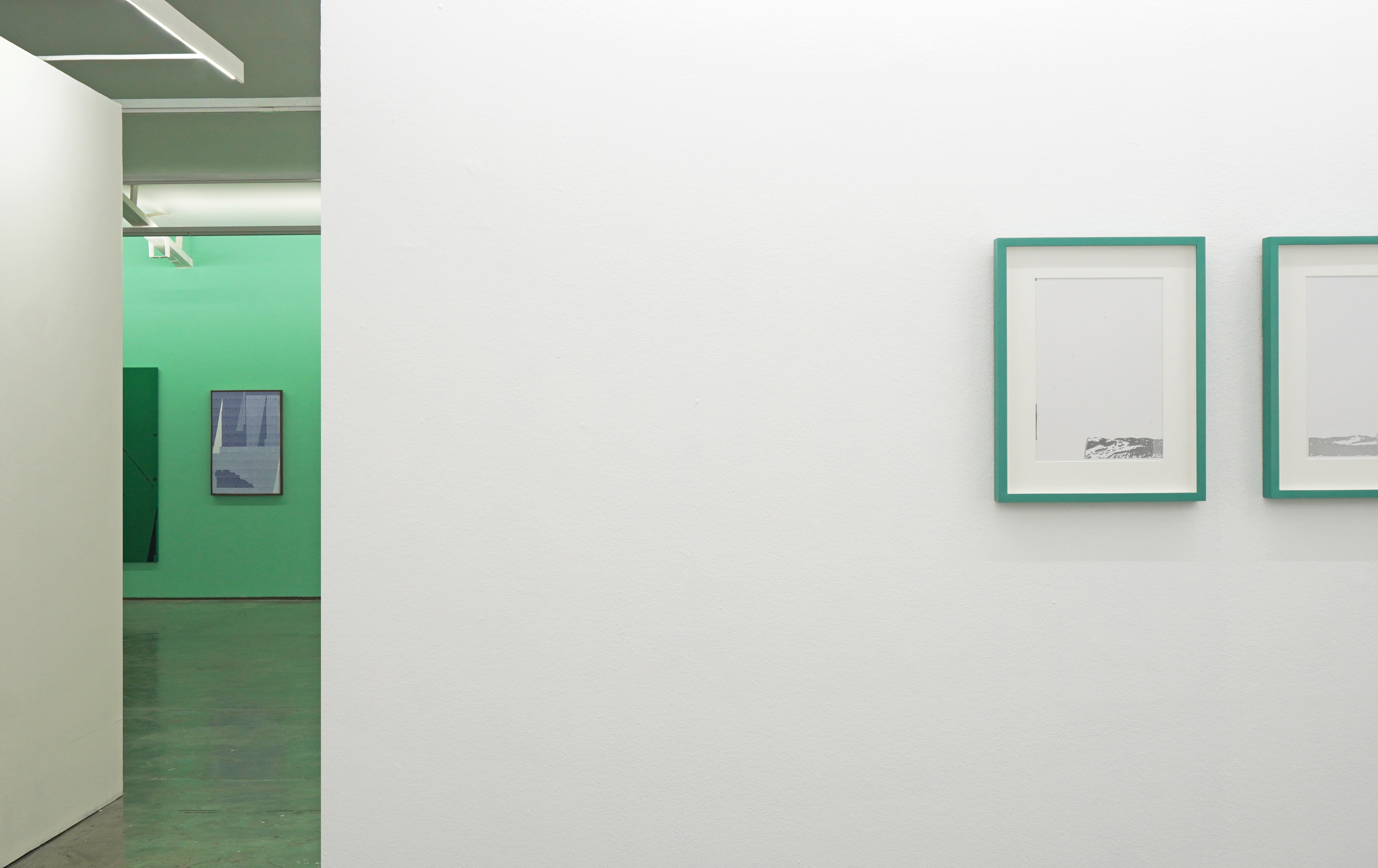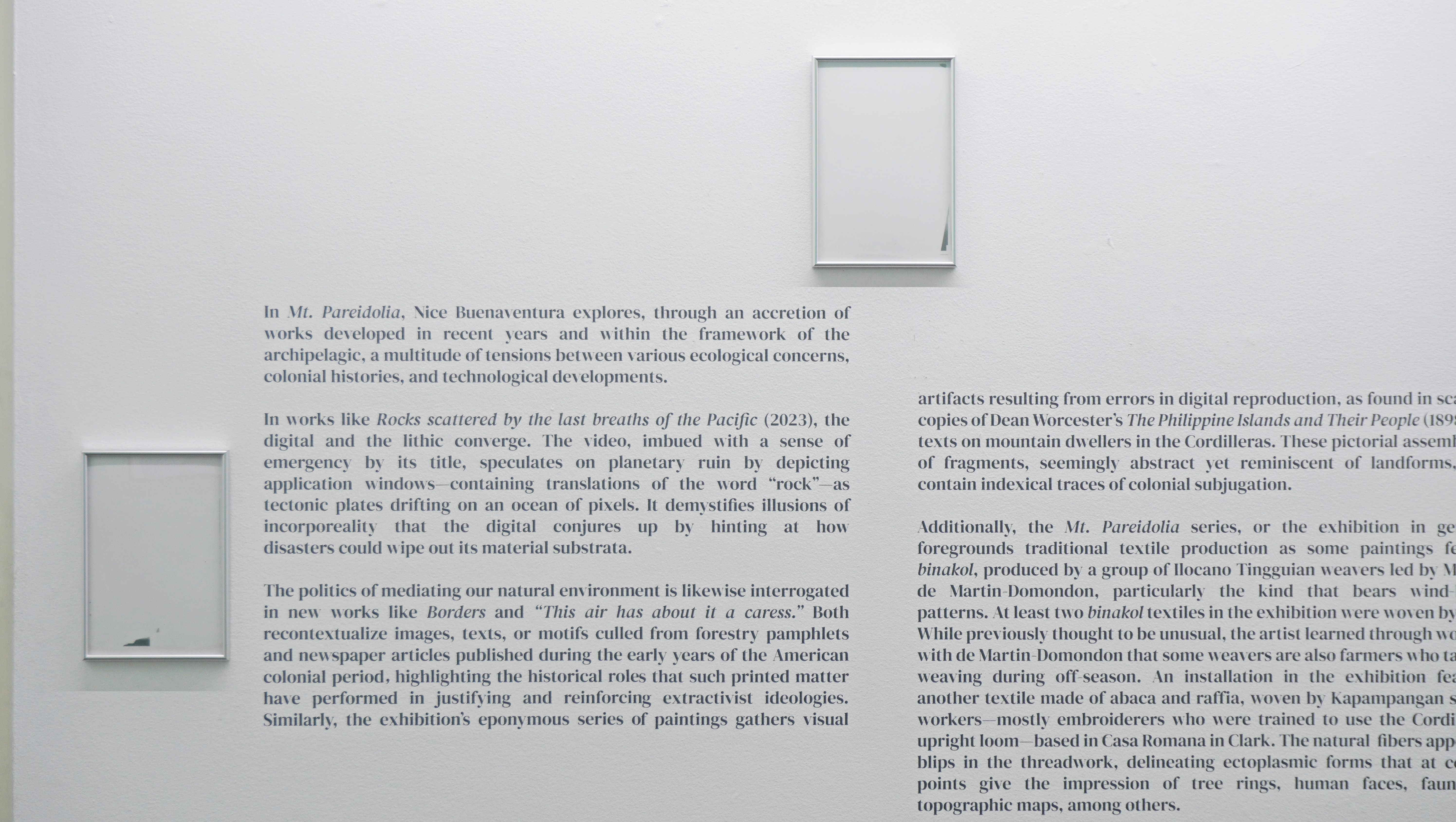EXHIBITIONS
Mt. Pareidolia
Artinformal
2024
In Mt. Pareidolia, Nice Buenaventura explores, through an accretion of works developed in recent years and within the framework of the archipelagic, a multitude of tensions between various ecological concerns, colonial histories, and technological developments.
In works like Rocks scattered by the last breaths of the Pacific (2023), the digital and the lithic converge. The video, imbued with a sense of emergency by its title, speculates on planetary ruin by depicting application windows—containing Austronesian translations of the word “rock”—as tectonic plates drifting on an ocean of pixels. It demystifies illusions of incorporeality that the digital conjures up by hinting at how disasters could wipe out its material substrata.
The politics of mediating our natural environment is likewise interrogated in new works like Borders and “This air has about it a caress.” Both recontextualize images, texts, or motifs culled from forestry pamphlets and newspaper articles published during the early years of the American colonial period, highlighting the historical roles that such printed matter have performed in justifying and reinforcing extractivist ideologies. Similarly, the exhibition’s eponymous series of paintings gathers visual artifacts resulting from errors in digital reproduction, as found in scanned copies of Dean Worcester’s The Philippine Islands and Their People (1898) and texts on mountain dwellers in the Cordilleras. These pictorial assemblages of fragments, seemingly abstract yet reminiscent of landforms, thus contain indexical traces of colonial subjugation.
Additionally, the Mt. Pareidolia series, or the exhibition in general, foregrounds traditional textile production as some paintings use binakol, produced by a group of Ilocano-Tingguian weavers led by Maricel de Martin-Domondon, particularly the kind that bears wind-based patterns. At least two binakol textiles in the exhibition were woven by men. While previously thought to be unusual, the artist learned through working with de Martin-Domondon that some weavers are also farmers who take up weaving during off-season. In another labor-focused installation, a textile made of abaca and raffia is featured, woven by Kapampangan skilled workers—embroiderers who were upskilled to use the Cordilleran upright loom—based in Casa Romana in Clark. The natural fibers appear as blips in the threadwork, delineating ectoplasmic forms that at certain points give the impression of tree rings, human faces, fauna, or topographic maps, among others.
Aside from evoking parallels between pixels, wood grain, indigenous motifs, and weather systems, these materializations of the artist’s ongoing research on weaving practices propose a keen sensitivity to the power dynamics in the production of art. The Mt. Pareidolia series gestures towards degrowth and resistance against development aggression, highlighting how such traditional conceptualizations of ecology possess a counter-hegemonic character, especially as semi-feudal conditions continue to be imposed by imperialism.
The porosity of the works and the exhibition lends itself to the pareidolic impulse to tease out associations, divine patterns, suggest connections, and invoke constellations of seemingly disparate elements from a flux of information. A fractal quality emerges as notions of the archipelagic permeate various levels, from the works to the artist’s oeuvre. Amidst the palpable threat and colossal scale of extinction and ecological collapse, Mt. Pareidolia sketches an almost bird’s-eye view of diverse paths through which we could think with all the randomness and contradictions.
— Dominic Zinampan
︎︎︎︎
Atop Mt. Pareidolia one is emboldened and humbled at once. Sheer altitude—and, perhaps, thin air—suspends all reality in favor of an imagined possession of some kind of magick1, while piercing through the same reverie with the fact of one’s smallness. In the presence of Land, where, what and why are we?
But mountain folk are more lucid than delirious here. So lucid, in fact, that they seem to have seen into the future. When the Itneg of Abra created the kusikus2, could they have known that the land would long after be spoken of in terms of wind signal3? Surely the winds then were far from the battering we continually suffer—a caress as a colonist once remarked4.
In a way pareidolia5 and clairvoyance are one and the same: seeing meaning in meaninglessness, seeing something in nothing. They lead one to know, but not to know better. Tribes revel in just-knowing, leaving the knowing-better to Land. Meanwhile, her cycles fade into the background of cosmopolitan conceits, unlike in the highlands or the plains of the countryside where people are a part of nature, not apart.
Of course, it is in the nature of kusikus to draw us back in. Look at it. Notice that it, among many other motifs used in traditional craft, repeat and form patterns. They are manmade analogs of the rhythms in nature, created by people long before the Spanish conquest. One could say that they knew Land and she knew them in the 1400s. One could also say that, outside of our corner of semi-feudalism6, climate vulnerability, and the grim zeitgeist of our epoch, moving forward means moving backward7.
***
1Real magick, as opposed to stage magic.
2Kusikus is Ilocano for whirlwind, also a popular motif of a type of inabel textile called the binakol.
3Modern day storms, especially in the Philippines, are monitored in mainstream media, alongside other factors, in terms of wind speed (signal no. 1, 2, etc.).
4A collection of American period pamphlets about Philippine forestry products includes a text about climate—how the atmosphere here was unlike any in the tropics, how “the air [had] about it a caress.” An excerpt containing this remark appears as a drawing in the exhibition.
5Pareidolia is a human tendency to see meaningful images in random patterns. As a child, I used to lose sleep over the mangled faces I saw in the woodgrain of the bunk bed I shared with my sister.
6To make ends meet, many weavers are also landless farmers—”nakikisaka lang sila.”
7”Moving forward means moving backward” is a recurring sentiment across several projects, beginning with Boolean Garden (2019–present), wherein the future is envisioned to be indigenous.
︎︎︎︎
Some things to consider when purchasing traditional textiles and other crafts, as well as engaging with weavers and artisans
- Pay more if able1. The binakol, for example, can go for as low as 200PhP per yard. It takes about two weeks to finish a roll, and yet it is sold at the same price point as most commercial-run, mass-produced textiles2. In today’s economy, traditional weavers feel the need to compete with textile manufacturers to participate in a market that favors the fast and the cheap.
-
When engaging with weavers or artisans in producing secondary goods like clothing and decor using their products, allow them a longer lead time to meet orders than you would mass manufacturers1. The reasons are quite obvious.
-
Ask about the history and traditional uses of a piece of textile or other craft to avoid inappropriate applications. Although traditional weavers and artisans have adapted to the times such that certain items with ritual or spiritual significance have been modified for use in contemporary life3, knowing their stories may further enrich the appreciation of their craft.
-
When using traditional textiles and crafts for luxury goods, pay the weavers and artisans commensurately. There is no universal formula for this. Gratuities, honorariums and royalties can be discussed with the artisans, preferably including the dynamics of the luxury market for transparency. As we celebrate their craftsmanship and artistry, they deserve a share in the markups on luxury goods.
- When featuring products using traditional textiles and other crafts in any project, share proper, well-researched attributions. The more specific, the better. Apart from general terms and categorizations, including the names of the weavers and artisans is good practice.
***
1In an online lecture titled ‘From Household to Digital Sales: Marketing Contemporary Textiles in the Northern Philippines’ organized by CordiTex in UP Baguio, Dr. Lynne Milgram of OCAD University (Anthropology) discussed the difficulties weavers face in the contemporary market, noting that paying more when able, as well as allowing longer lead times, are some of the ways to fairly treat labor-intensive craftwork.
2As compared to prices of textiles sold at the Kamuning Textile Market in Quezon City.
3During the most recent Likha Trade Fair organized by DTI, weavers from Abra and Ifugao Province shared upon asking that wares offered in the contemporary market have been modified for non-ritual applications (e.g. introducing new colors to binakol according to Madelyn Cudiamat, and changing motif counts in Ifugao ikat according to Sammy Buhle).
︎︎︎︎
This exhibition features weaving by Maricel de Martin-Domondon, Jackie Apuya, Charlotte Tejada and Rolando Barwela (Abra), and Jhon, Lina and Erica of Casa Romana (Pampanga).





















